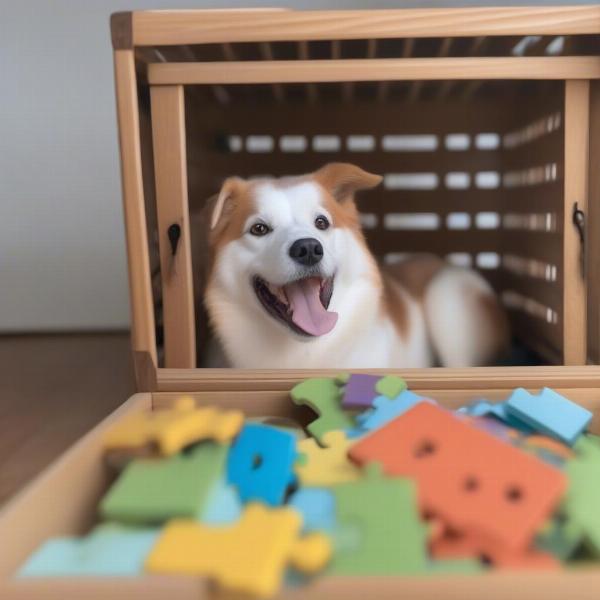Dealing with a dog that escapes its crate can be frustrating and concerning. This article will delve into the reasons behind crate escapes, offer practical solutions to prevent them, and provide valuable insights into creating a positive crate training experience for your furry friend.
Understanding Why Your Dog Escapes the Crate
Several factors can contribute to a dog’s desire to escape its crate. Is your dog bored? A lack of mental and physical stimulation can lead to restlessness and a desperate attempt to find something more interesting to do. Separation anxiety is another common culprit. Dogs experiencing separation anxiety may become distressed when left alone and try to escape to find their owner. Sometimes, the crate itself might be the problem. An improperly sized crate, either too large or too small, can encourage escape attempts. A crate that’s too large allows a dog to designate separate areas for sleeping and eliminating, defeating the purpose of crate training. A crate that’s too small can be uncomfortable and confining. Finally, your dog may simply not be properly crate trained. A gradual introduction to the crate, paired with positive reinforcement, is essential for a successful crate training experience.
Preventing Crate Escapes: Practical Tips and Strategies
Addressing the root cause of the escape attempts is the first step in preventing future escapes. Ensure your dog receives adequate exercise and mental stimulation before being crated. Puzzle toys, chew toys, and even a frozen Kong filled with treats can keep your dog occupied and entertained while confined.  Dog entertained in crate with puzzle toy If separation anxiety is suspected, consult with a veterinarian or a certified professional dog trainer for guidance on behavior modification techniques. dog travel crate Making the crate a comfortable and inviting space can also deter escape attempts. Ensure the crate is appropriately sized, providing enough room for your dog to stand, turn around, and lie down comfortably. Add soft bedding, familiar toys, and a blanket or article of clothing with your scent to create a sense of security.
Dog entertained in crate with puzzle toy If separation anxiety is suspected, consult with a veterinarian or a certified professional dog trainer for guidance on behavior modification techniques. dog travel crate Making the crate a comfortable and inviting space can also deter escape attempts. Ensure the crate is appropriately sized, providing enough room for your dog to stand, turn around, and lie down comfortably. Add soft bedding, familiar toys, and a blanket or article of clothing with your scent to create a sense of security.
Crate Training: Building a Positive Association
Proper crate training is crucial for preventing escapes and fostering a positive relationship with the crate. Introduce the crate gradually, starting by placing treats and toys inside to encourage your dog to enter voluntarily. Never force your dog into the crate. Feed your dog meals near or inside the crate to build a positive association. Gradually increase the duration of time your dog spends in the crate, always starting with short periods and rewarding calm behavior. Avoid using the crate as a form of punishment. The crate should be a safe haven, not a place of confinement. zelda dog collar Consistency and patience are key to successful crate training. With time and positive reinforcement, your dog will learn to view the crate as a comfortable and secure space.
Conclusion: Creating a Secure and Happy Crate Experience
A dog escaping its crate can be a sign of underlying issues, such as boredom, separation anxiety, or improper crate training. By addressing these issues and implementing the tips outlined in this article, you can create a positive crate experience for your dog, preventing escapes and ensuring their safety and well-being. Remember, patience and consistency are key to success. large heavy duty dog crate
FAQ:
- Why does my dog bark when crated? This can be due to boredom, anxiety, or a need to eliminate.
- How long can I leave my dog in a crate? This depends on the dog’s age and individual needs, but generally, adult dogs should not be crated for more than 6-8 hours at a time.
- What should I do if my dog continues to escape the crate? Consult with a professional dog trainer or veterinarian for personalized guidance.
- Can I use a crate for puppies? Yes, crate training can be very beneficial for puppies, aiding in housebreaking and providing a sense of security.
- What type of crate is best for my dog? The best type of crate depends on your dog’s size, breed, and individual needs. 1 dozen dog proof traps
- How do I make my dog’s crate comfortable? Provide soft bedding, familiar toys, and a blanket or item of clothing with your scent.
- Is it cruel to crate train a dog? No, when done correctly, crate training provides a safe and secure den-like space for your dog. the range dog cage
ILM Dog is your go-to resource for expert advice on all aspects of dog care, from breed selection and health to training and nutrition. We offer a wealth of information to help you provide the best possible care for your canine companion. For personalized advice or to learn more about our services, contact us via email at [email protected] or call us at +44 20-3965-8624. ILM Dog is committed to helping you build a strong and loving bond with your furry friend.